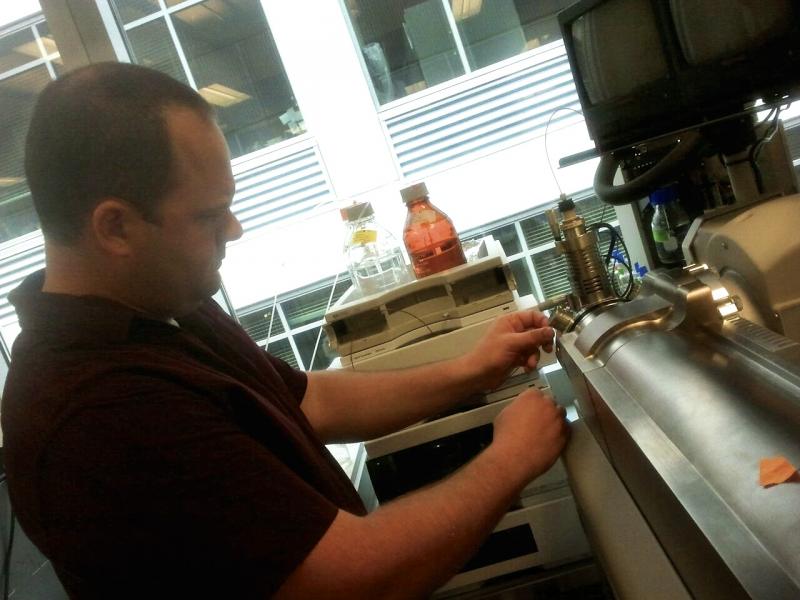One of ISB’s Superpowers: Mass Spectrometry
 isbscience.org/news/2012/07/24/one-of-isbs-superpowers-mass-spectrometry/
isbscience.org/news/2012/07/24/one-of-isbs-superpowers-mass-spectrometry/
Above: Mark Sartain at the quadrupole time of flight mass spectrometer.
By Terry Farrah
I recently observed ISB at its creative, cross-disciplinary, collaborative best. The story came to my attention during a lab meeting and it involved Dr. Mark Sartain, whose desk is kitty corner to mine.
The background: Drs. Elizabeth Gold and Stephen Ramsey, researchers in the laboratory of Dr. Alan Aderem, who co-founded ISB and is now the president of Seattle BioMed, were trying to understand atherosclerosis. It was already known that a mispriming of the immune system was involved in the disease, which hardens the arteries, but they suspected additional immune system involvement. They had evidence that the protein ATF3, known to regulate aspects of immune response, might also regulate the production of 25-hydroxycholesterol. This molecule promotes lipid accumulation in some immune system cells and may promote atherosclerosis.
Like its cousin cholesterol, already well-known to be involved in atherosclerosis, 25-hydroxycholesterol (see illustration) is a type of lipid. Lipids are small biological molecules defined by their water-repellency: throw a lipid into a bottle of salad dressing and it will hang out with the oil instead of floating around in the vinegar. Dietary fats are examples of lipids. Depending on how you count, there are between 9000 and 100,000 different kinds of lipids in the human body, and they perform critical roles ranging from energy storage to the regulation of cell growth and death. But, when certain kinds of lipids are out of balance, they can cause disease.
Mass spec to the rescue
Liz and Steve knew that Mark had been recruited by the Moritz Group at ISB for his expertise in lipids. They asked Mark for assistance in developing an assay for 25-hydroxycholesterol using high-pressure liquid chromotography (HPLC).
Mark not only agreed to help, he knew a better way to do the job: mass spectrometry.
Our lab at ISB has more than a dozen different types of mass spec instruments. Using the quadrupole time of flight mass spec, Mark was able to measure the molecule with much greater sensitivity and specificity, giving more reliable results than HPLC. Mark developed and performed the mass spec assay, and Liz and Steve’s hypothesis proved to be correct. See their paper in the April 2012 Journal of Experimental Medicine.
What are the health implications of Liz, Steve, and Mark’s discovery? It raises the possibility that, in humans, a defect in ATF3 expression or function could increase susceptibility to atherosclerosis. The unexpected role of ATF3 in regulating macrophage lipid metabolism could also lead to new ideas about drug targets for prevention of atherosclerosis.
I asked Mark what’s interesting about lipids.
“Maybe just that they are so underappreciated,” he said. “We learn in undergrad biochem that there are four types of biological macromolecules: nucleic acids (DNA, for example), proteins, sugars and lipids. For some reason the latter two are often tossed aside, yet they are just as important for a functioning biological system.”
Mark first started working with lipids while studying tuberculosis.
“Mycobacterium tuberculosis produces a fascinating array of unique and complex lipids, and we wanted to understand how the lipid profiles changed during an infection,” he said. “This necessitated developing a new mass spectrometry-based strategy.”
Mark is now employing that strategy using the mass spectrometer equipment typically used in our lab to measure protein molecules. “A proteomics lab is ideally suited for lipid analysis as the instrumentation is essentially the same. I’m just programming the mass spectrometer to look for lipid ions (instead of protein fragment ions).”
Even though Liz and Steve have have moved with the Aderem lab to Seattle BioMed, they still with Mark almost weekly.
Terry Farrah is a software developer in the Moritz lab at ISB. She was a double major in biochemistry and computer science at UC Berkeley, received her MS in Computer Science at the University of Washington, and worked at Immunex and ZymoGenetics before joining ISB in 2008. She loves proteins (both to eat and to study).





